
Computer Science Illuminated
7th Edition
ISBN: 9781284155617
Author: Nell Dale, John Lewis
Publisher: Jones & Bartlett Learning
expand_more
expand_more
format_list_bulleted
Question
Chapter 8, Problem 47E
Program Plan Intro
Binary search tree:
- Binary search tree is a tree; the nodes are sorted in the semantic order.
- Binary search tree nodes can have zero, one, or two children.
- Node without children is called a leaf or end node.
- A node that does not have a superior node is called a root node or starting node.
- In binary search tree, the left subtree contains the nodes lesser than the root node.
- The right subtree contains the nodes greater than the root node.
- The binary search will performed until finding a search node or reaching the end of the tree.
Expert Solution & Answer
Explanation of Solution
Insertion of elements in the binary search tree:
Given elements to construct a binary search tree are as follows:
50, 72, 96, 107, 26, 12, 11, 9, 2, 10, 25, 51, 16, 17, 95.
Step 1:
Insert the element 50, which is the root node of a binary search tree.

Step 2:
Next element is 72, which is greater than root node element 50, so insert the element 72 as the right child of the root node.
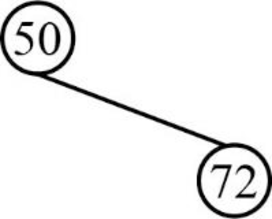
Step 3:
- Next element is 96, which is greater than root node element 50, so insert the element 96 as the right child of the root node.
- The root node already contains the element 72 as the right child and the element 96 is greater than the element 72.
- So, insert the element 96 as the right child of 72.
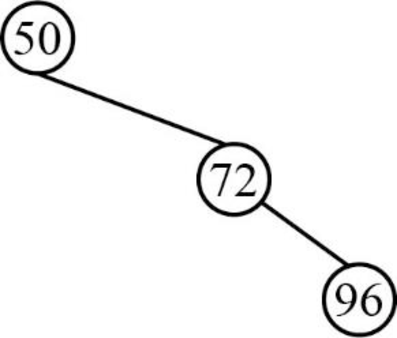
Step 4:
- Next element is 107, which is greater than root node element 50, so insert the element 107 as the right child of the root node.
- The root node already contains the element 72 as the right child and the element 107 is greater than the element 72.
- The element 72 already contains the element 96 as the right child and the element 107 is greater than the element 96.
- So, insert the element 107 as the right child of 96.
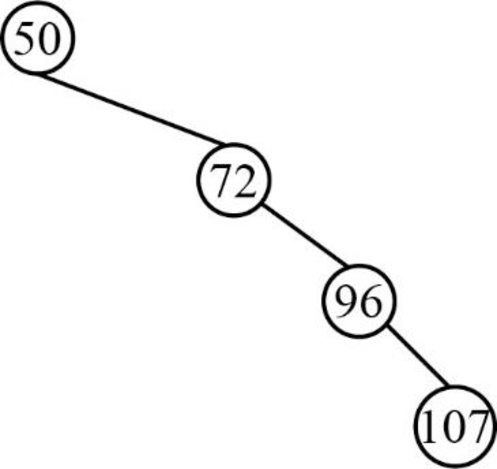
Step 5:
Next element is 26, which is less than root node value 50, so insert the element 26 as the left child of the root node.
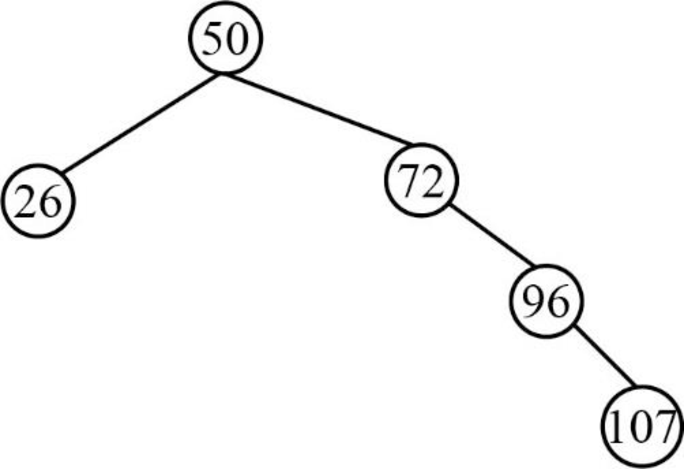
Step 6:
- Next element is 12, which is less than the root node value 50, so insert the element 12 as left child of the root node.
- The root node already contains the element 26 as the left child and the element 12 is less than the element 26.
- So, insert the element 12 as left child of the element 26.
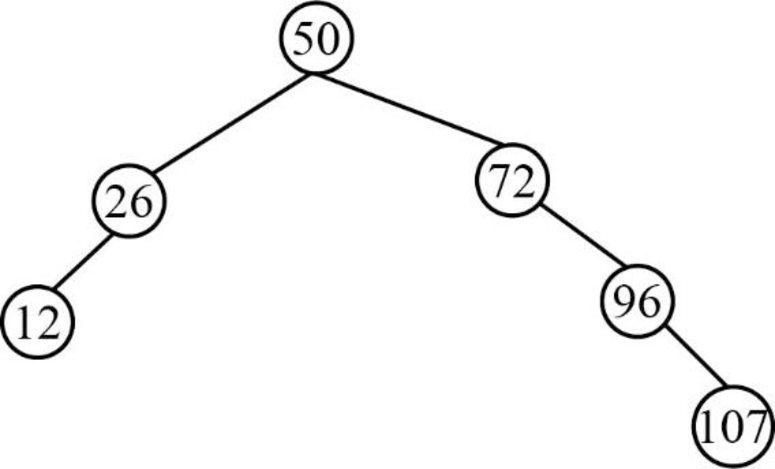
Step 7:
- Next element is 11, which is less than the root node value 50, so insert the element 11 as left child of the root node.
- The root node already contains the element 26 as the left child and the element 11 is less than the element 26.
- The element 26 already contains the element 12 as the left child and the element 11 is lesser than the element 12.
- So, insert the element 11 as left child of the element 12.
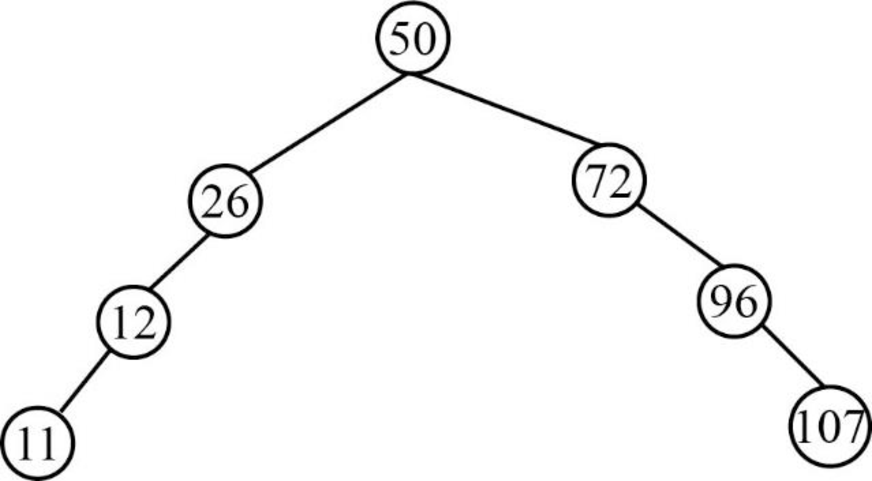
Step 8:
- Next element is 9, which is less than the root node value 50, so insert the element 9 as left child of the root node.
- The root node already contains the element 26 as the left child and the element 9 is less than the element 26.
- The element 26 already contains the element 12 as the left child and the element 9 is lesser than the element 12.
- The element 12 already contains the element 11 as the left child and the element 9 is lesser than the element 11.
- So, insert the element 9 as left child of the element 11.
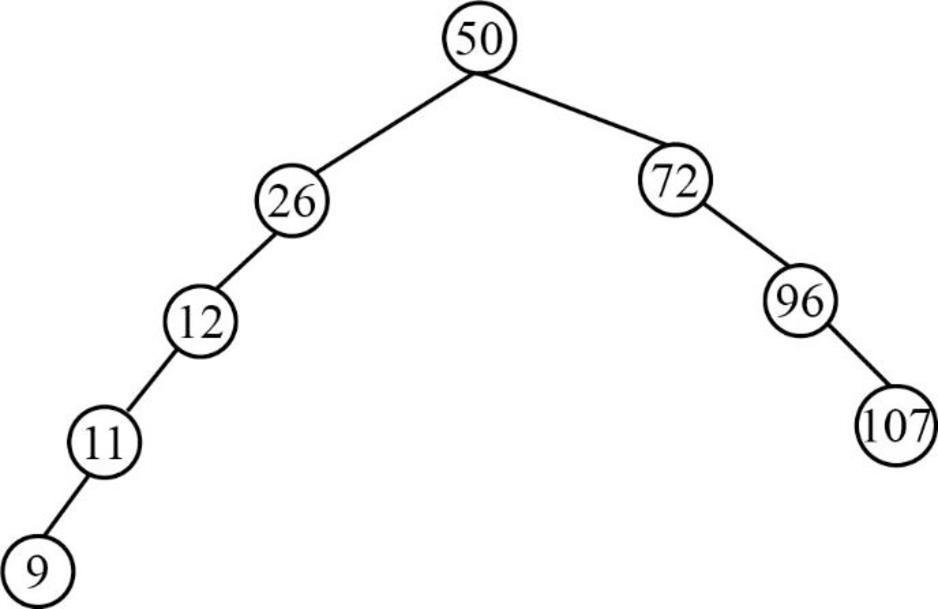
Step 9:
- Next element is 2, which is less than the root node value 50, so insert the element 2 as left child of the root node.
- The root node already contains the element 26 as the left child and the element 2 is less than the element 26.
- The element 26 already contains the element 12 as the left child and the element 2 is lesser than the element 12.
- The element 12 already contains the element 11 as the left child and the element 2 is lesser than the element 11.
- The element 11 already contains the element 9 as the left child and the element 2 is lesser than the element 9.
- So, insert the element 2 as left child of the element 9.
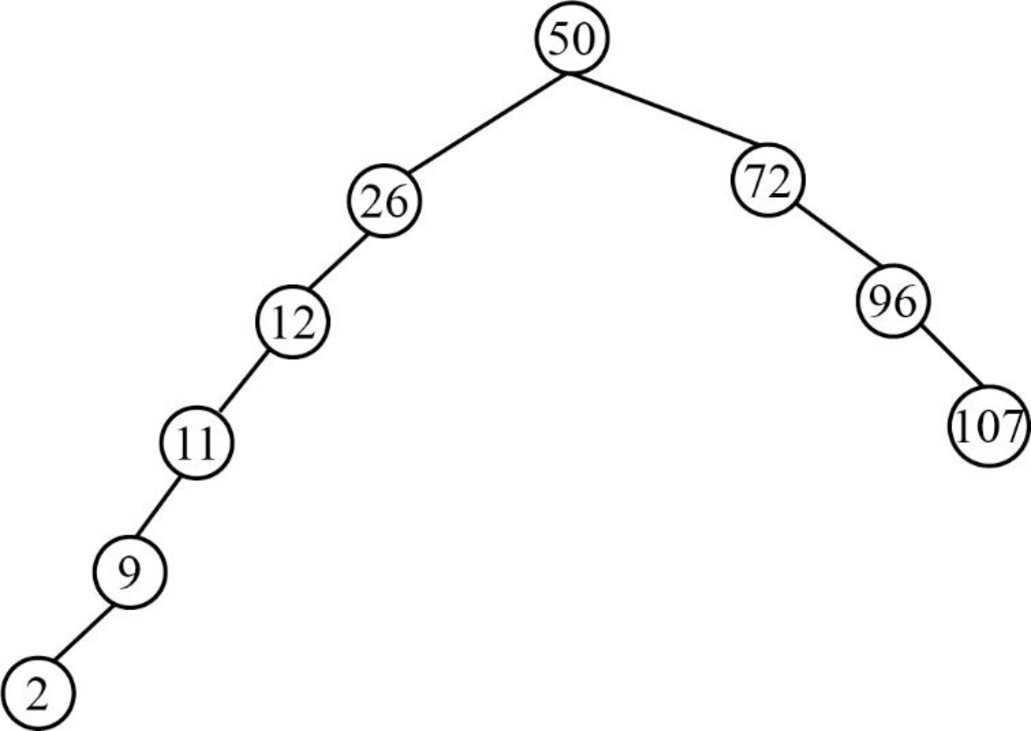
Step 10:
- Next element is 10, which is less than the root node value 50, so insert the element 10 as left child of the root node.
- The root node already contains the element 26 as the left child and the element 10 is less than the element 26.
- The element 26 already contains the element 12 as the left child and the element 10 is lesser than the element 12.
- The element 12 already contains the element 11 as the left child and the element 10 is lesser than the element 11.
- The element 11 already contains the element 9 as the left child and the element 10 is greater than the element 9.
- So, insert the element 10 as right child of the element 9.
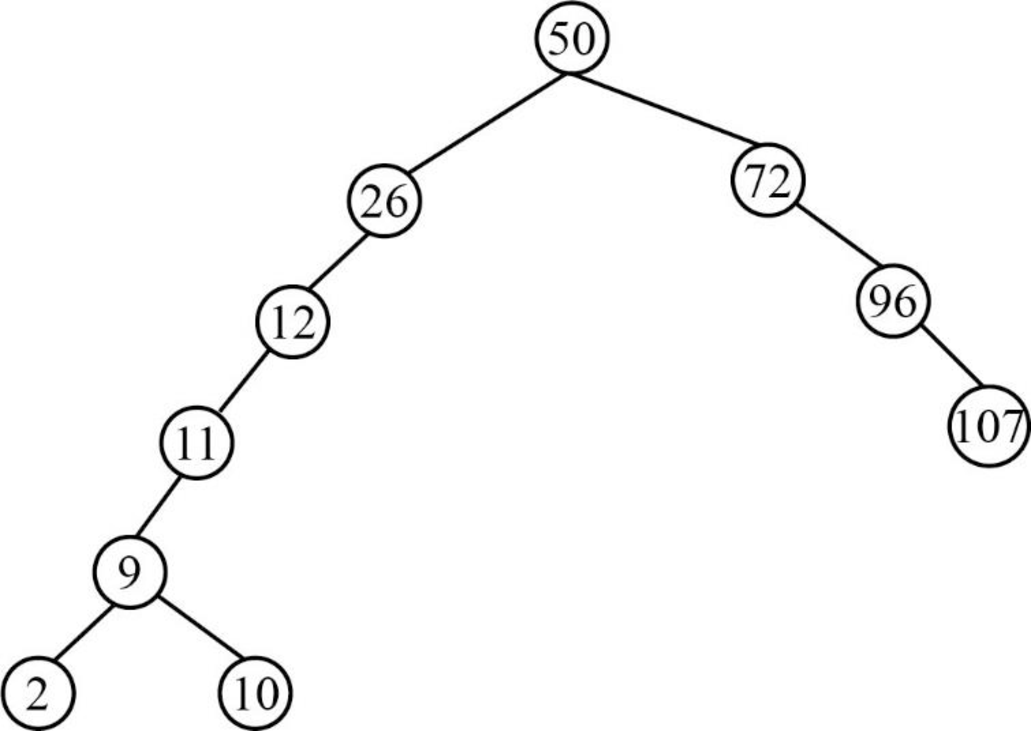
Step 11:
- Next element is 25, which is less than the root node value 50, so insert the element 25 as left child of the root node.
- The root node already contains the element 26 as the left child and the element 25 is less than the element 26.
- The element 26 already contains the element 12 as the left child and the element 25 is greater than the element 12.
- So, insert the element 25 as right child of the element 12.
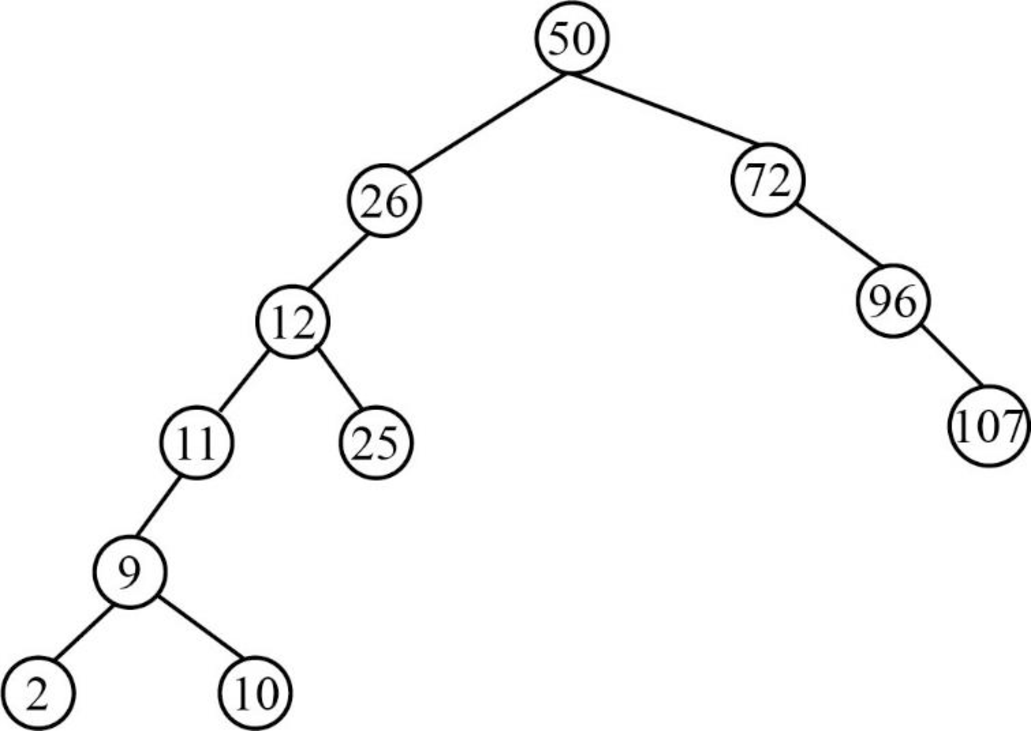
Step 12:
- Next element is 51, which is greater than root node element 50, so insert the element 51 as the right child of the root node.
- The root node already contains the element 72 as the right child and the element 51 is lesser than the element 72.
- So, insert the element 51 as the left child of 72.
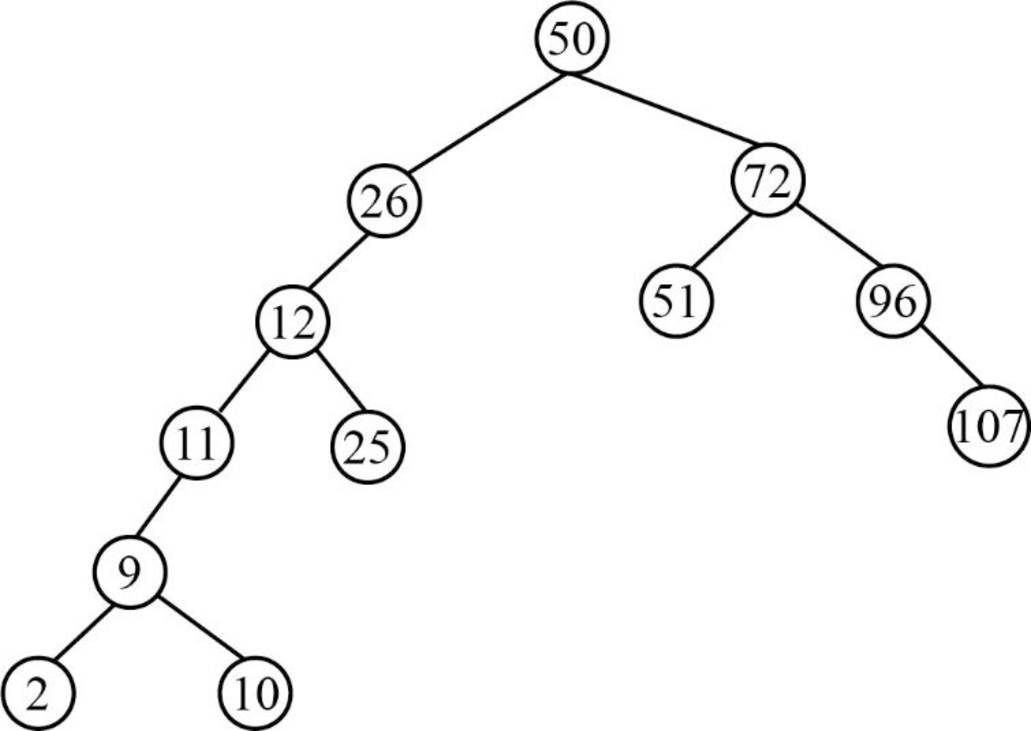
Step 13:
- Next element is 16, which is less than the root node value 50, so insert the element 16 as left child of the root node.
- The root node already contains the element 26 as the left child and the element 16 is less than the element 26.
- The element 26 already contains the element 12 as the left child and the element 16 is greater than the element 12.
- The element 12 already contains the element 25 as the right child and the element 16 is lesser than the element 25.
- So, insert the element 16 as left child of the element 25.
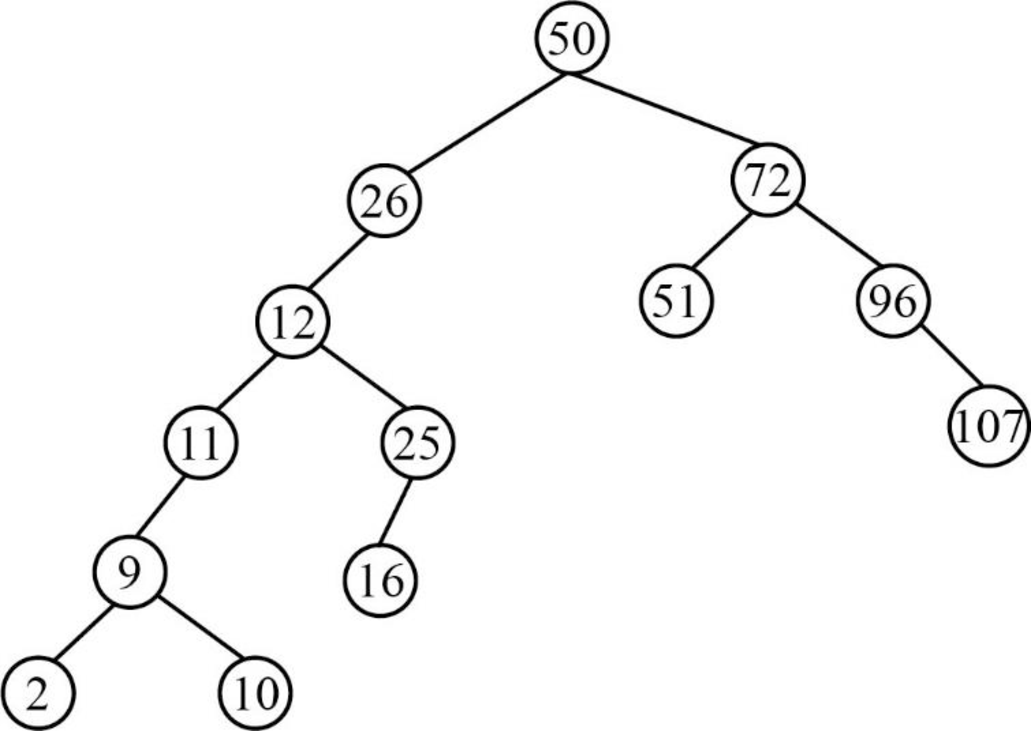
Step 14:
- Next element is 17, which is less than the root node value 50, so insert the element 17 as left child of the root node.
- The root node already contains the element 26 as the left child and the element 17 is less than the element 26.
- The element 26 already contains the element 12 as the left child and the element 17 is greater than the element 12.
- The element 12 already contains the element 25 as the right child and the element 17 is lesser than the element 25.
- The element 25 already contains the element 16 as the left child and the element 17 is greater than the element 16.
- So, insert the element 17 as right child of the element 16.
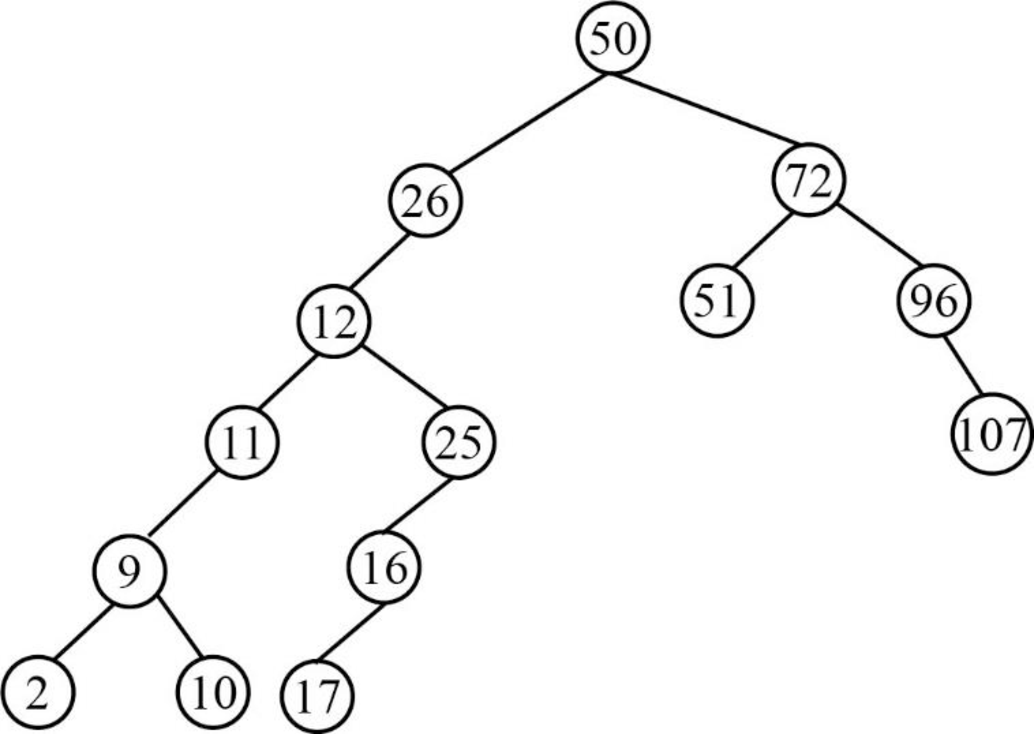
Step 15:
- Next element is 95, which is greater than root node element 50, so insert the element 95 as the right child of the root node.
- The root node already contains the element 72 as the right child and the element 95 is greater than the element 72.
- The element 72 already contains the element 96 as the right child and the element 95 is lesser than the element 96.
- So, insert the element 95 as the left child of 96.
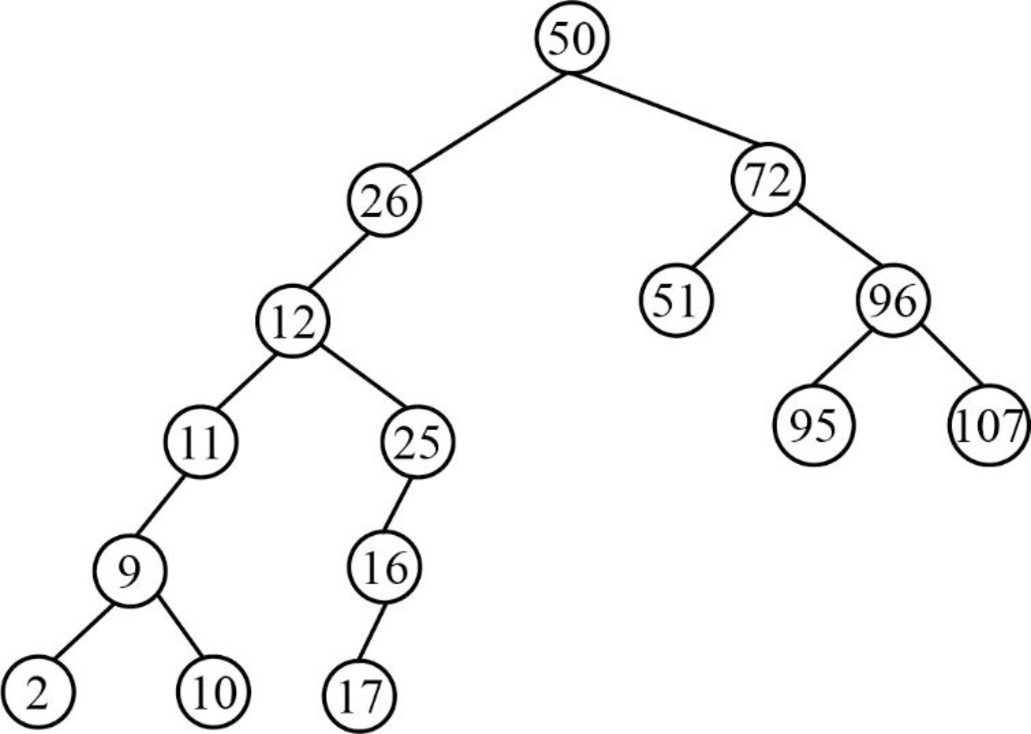
Therefore, the above tree is the final constructed binary search tree for the given elements.
Want to see more full solutions like this?
Subscribe now to access step-by-step solutions to millions of textbook problems written by subject matter experts!
Students have asked these similar questions
Considering the TM example of binary sum ( see attached)do the step-by-step of execution for the binary numbers 1101 and 11.
Feel free to use the Formal Language Editor Tool to execute it;
Write it down the current state of the tape (including the head position) and indicate the current state of the TM at each step.
I need help on inculding additonal code where I can can do the opposite code of MatLab, where the function of t that I enter becomes the result of F(t), in other words, turning the time-domain f(t) into the frequency-domain function F(s):
I need help with the TM computation step-by-step execution for the binary numbers 1101 and 11.
Formal Language Editor Tool can be used to execute it; Write it down the current state of the tape (including the head position) and indicate the current state of the TM at each step;
Chapter 8 Solutions
Computer Science Illuminated
Ch. 8 - Prob. 1ECh. 8 - Prob. 2ECh. 8 - Prob. 3ECh. 8 - Prob. 4ECh. 8 - Prob. 5ECh. 8 - Prob. 6ECh. 8 - Prob. 7ECh. 8 - Prob. 8ECh. 8 - Prob. 9ECh. 8 - Prob. 10E
Ch. 8 - Prob. 11ECh. 8 - Prob. 12ECh. 8 - Prob. 13ECh. 8 - Prob. 14ECh. 8 - Prob. 15ECh. 8 - Prob. 16ECh. 8 - Prob. 17ECh. 8 - Prob. 18ECh. 8 - Prob. 19ECh. 8 - Prob. 20ECh. 8 - Prob. 21ECh. 8 - Prob. 22ECh. 8 - Prob. 23ECh. 8 - Prob. 24ECh. 8 - Prob. 25ECh. 8 - Prob. 26ECh. 8 - Prob. 27ECh. 8 - Prob. 28ECh. 8 - Prob. 29ECh. 8 - Prob. 30ECh. 8 - Prob. 31ECh. 8 - Prob. 32ECh. 8 - Prob. 33ECh. 8 - Prob. 34ECh. 8 - Prob. 35ECh. 8 - Prob. 36ECh. 8 - Prob. 37ECh. 8 - Prob. 38ECh. 8 - Prob. 39ECh. 8 - Prob. 40ECh. 8 - Prob. 41ECh. 8 - Prob. 42ECh. 8 - Prob. 43ECh. 8 - Prob. 44ECh. 8 - Prob. 45ECh. 8 - Prob. 46ECh. 8 - Prob. 47ECh. 8 - Prob. 48ECh. 8 - Prob. 49ECh. 8 - Prob. 50ECh. 8 - Prob. 51ECh. 8 - Prob. 52ECh. 8 - Prob. 53ECh. 8 - Prob. 54ECh. 8 - Prob. 55ECh. 8 - Prob. 56ECh. 8 - Prob. 57ECh. 8 - Prob. 58ECh. 8 - Prob. 59ECh. 8 - Prob. 60ECh. 8 - Prob. 61ECh. 8 - Prob. 62ECh. 8 - Prob. 66ECh. 8 - Prob. 67ECh. 8 - Prob. 68ECh. 8 - Prob. 69ECh. 8 - Prob. 1TQCh. 8 - Prob. 2TQCh. 8 - Prob. 4TQ
Knowledge Booster
Similar questions
- Ensure you answer the question asked at the end of the document. Do not just paste things without the GNS3 console outputsarrow_forward"Do not use AI tools. Solve the problem by hand on paper only and upload a photo of your handwritten solution."arrow_forward"Do not use AI tools. Solve the problem by hand on paper only and upload a photo of your handwritten solution."arrow_forward
- "Do not use AI tools. Solve the problem by hand on paper only and upload a photo of your handwritten solution."arrow_forward"Do not use AI tools. Solve the problem by hand on paper only and upload a photo of your handwritten solution."arrow_forwardSolve this "Do not use AI tools. Solve the problem by hand on paper only and upload a photo of your handwritten solution."arrow_forward
- "Do not use AI tools. Solve the problem by hand on paper only and upload a photo of your handwritten solution."arrow_forward"Do not use AI tools. Solve the problem by hand on paper only and upload a photo of your handwritten solution."arrow_forwardSpecifications: Part-1Part-1: DescriptionIn this part of the lab you will build a single operation ALU. This ALU will implement a bitwise left rotation. Forthis lab assignment you are not allowed to use Digital's Arithmetic components.IF YOU ARE FOUND USING THEM, YOU WILL RECEIVE A ZERO FOR LAB2!The ALU you will be implementing consists of two 4-bit inputs (named inA and inB) and one 4-bit output (named out). Your ALU must rotate the bits in inA by the amount given by inB (i.e. 0-15).Part-1: User InterfaceYou are provided an interface file lab2_part1.dig; start Part-1 from this file.NOTE: You are not permitted to edit the content inside the dotted lines rectangle. Part-1: ExampleIn the figure above, the input values that we have selected to test are inA = {inA_3, inA_2, inA_1, inA_0} = {0, 1, 0,0} and inB = {inB_3, inB_2, inB_1, inB_0} = {0, 0, 1, 0}. Therefore, we must rotate the bus 0100 bitwise left by00102, or 2 in base 10, to get {0, 0, 0, 1}. Please note that a rotation left is…arrow_forward
arrow_back_ios
SEE MORE QUESTIONS
arrow_forward_ios
Recommended textbooks for you
 Database System ConceptsComputer ScienceISBN:9780078022159Author:Abraham Silberschatz Professor, Henry F. Korth, S. SudarshanPublisher:McGraw-Hill Education
Database System ConceptsComputer ScienceISBN:9780078022159Author:Abraham Silberschatz Professor, Henry F. Korth, S. SudarshanPublisher:McGraw-Hill Education Starting Out with Python (4th Edition)Computer ScienceISBN:9780134444321Author:Tony GaddisPublisher:PEARSON
Starting Out with Python (4th Edition)Computer ScienceISBN:9780134444321Author:Tony GaddisPublisher:PEARSON Digital Fundamentals (11th Edition)Computer ScienceISBN:9780132737968Author:Thomas L. FloydPublisher:PEARSON
Digital Fundamentals (11th Edition)Computer ScienceISBN:9780132737968Author:Thomas L. FloydPublisher:PEARSON C How to Program (8th Edition)Computer ScienceISBN:9780133976892Author:Paul J. Deitel, Harvey DeitelPublisher:PEARSON
C How to Program (8th Edition)Computer ScienceISBN:9780133976892Author:Paul J. Deitel, Harvey DeitelPublisher:PEARSON Database Systems: Design, Implementation, & Manag...Computer ScienceISBN:9781337627900Author:Carlos Coronel, Steven MorrisPublisher:Cengage Learning
Database Systems: Design, Implementation, & Manag...Computer ScienceISBN:9781337627900Author:Carlos Coronel, Steven MorrisPublisher:Cengage Learning Programmable Logic ControllersComputer ScienceISBN:9780073373843Author:Frank D. PetruzellaPublisher:McGraw-Hill Education
Programmable Logic ControllersComputer ScienceISBN:9780073373843Author:Frank D. PetruzellaPublisher:McGraw-Hill Education

Database System Concepts
Computer Science
ISBN:9780078022159
Author:Abraham Silberschatz Professor, Henry F. Korth, S. Sudarshan
Publisher:McGraw-Hill Education

Starting Out with Python (4th Edition)
Computer Science
ISBN:9780134444321
Author:Tony Gaddis
Publisher:PEARSON

Digital Fundamentals (11th Edition)
Computer Science
ISBN:9780132737968
Author:Thomas L. Floyd
Publisher:PEARSON

C How to Program (8th Edition)
Computer Science
ISBN:9780133976892
Author:Paul J. Deitel, Harvey Deitel
Publisher:PEARSON

Database Systems: Design, Implementation, & Manag...
Computer Science
ISBN:9781337627900
Author:Carlos Coronel, Steven Morris
Publisher:Cengage Learning

Programmable Logic Controllers
Computer Science
ISBN:9780073373843
Author:Frank D. Petruzella
Publisher:McGraw-Hill Education